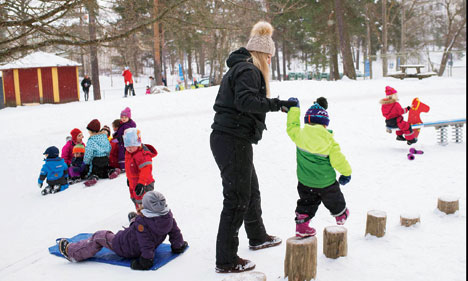
Stockholm: Something was wrong with the Penguins, the incoming class of toddlers at the Seafarer's Preschool, in a wooded suburb south of Stockholm.
The boys were clamorous and physical. They shouted and hit. The girls held up their arms and whimpered to be picked up. The group of one and two-year-olds had, in other words, split along traditional gender lines. And at this school, that is not OK.
Their teachers cleared the room of cars and dolls. They put the boys in charge of the play kitchen. They made the girls practise shouting "No!" Then they decided to open a proper investigation, erecting video cameras in the classroom.
Science may still be divided over whether gender differences are rooted in biology or culture, but many of Sweden's government-funded preschools are doing what they can to deconstruct them.
In many Swedish preschools, teachers avoid referring to their students' gender - instead of "boys and girls", they say "friends" or call children by name.
Play is organised to prevent children from sorting themselves by gender. A gender-neutral pronoun, "hen", was introduced in 2012 and was swiftly absorbed into mainstream Swedish culture, something linguists say has never happened in another country.
Exactly how this teaching method affects children is still unclear.
One of the few peer-reviewed efforts to examine the method's effects, published last year in the Journal of Experimental Child Psychology, concluded that some behaviours do go away when students attend "gender-neutral" preschools.
For instance, the children at these schools do not show a strong preference for playmates of the same gender, and are less likely to make assumptions based on stereotypes. Yet, the scientists found no difference at all in the children's tendency to notice gender, suggesting that may be under a genetic influence.
On a recent Friday, Elis Storesund, the Seafarer's Preschool's in-house gender expert, sat bent over a work sheet with two teachers of the four and five-year-old Seagulls, reviewing their progress on gender objectives.
"When we are drawing," said Melisa Esteka, 31, one of the teachers, "we see that the girls - they draw a lot - they draw girls with lots of makeup and long eyelashes. It's very clear that they are girls. We ask, 'Don't boys have eyelashes?' And they say, 'We know it is not like that in real life.'"
Storesund, 54, nodded thoughtfully. "They are trying to understand what it is to be a girl," she said.
Esteka looked frustrated. She had set a goal for herself: to stop the children identifying things as "for girls" or "for boys". But lately, her students were absorbing stereotypes from billboards and cartoons, and sometimes it seemed like all the slow, systematic work of the preschool was flying away overnight.
Sweden's experiment in gender-neutral preschools began in 1996 in Trodje, a small town near the edge of the Baltic Sea. The man who started it, Ingemar Gens, was not an educator but a journalist who dabbled in anthropology and gender theory.
Two schools rolled out what was called a compensatory gender strategy. Boys and girls at the preschools were separated for part of the day and coached in traits associated with the other gender. Boys massaged each other's feet. Girls were led in barefoot walks in the snow, and told to throw open the window and scream.
A wave of criticism broke out, but that was expected. "They said we were indoctrinating the kids," said Gens, now 68. "I say we're always indoctrinating kids. Bringing them up is indoctrination."
The strategy of separating boys and girls was later set aside in favour of a "gender-neutral" approach, intent on muting differences.
In 1998, Sweden tweaked its national curriculum requiring that all preschools "counteract traditional gender roles and gender patterns" and encourage children to explore "outside the limitations of stereotyped gender roles".
Traditionalists have raised occasional protests, complaining of liberal brainwashing. The far-Right Sweden Democrats party, which won about 13 per cent of the vote in 2014, has promised to roll back teaching that "seeks to change all children and young people's behaviour and gender identity".
But gender-equality policies enjoy the support of Sweden's largest parties, the centre-Left Social Democrats and the centre-Right Moderates.
In Trodje, the first wave of preschoolers to attend gender-neutral preschools are now 20-somethings. Elin Gerdin, 26, part of that first wave, is studying to be a teacher.
In appearance she is conventionally feminine, her long dark hair coaxed into spirals with a curling iron. This is something she points out - that in appearance she is conventionally feminine. It is the first sign that she views gender as something you could put on or take off, like a raincoat.
There are moments when her early education comes back to her in flashes.
Gerdin's friends have begun to have babies, and they post pictures of them on Facebook, swathed in blue or pink, in society's first act of sorting. Gerdin gets upset when this happens. She makes it a point to seek her friends out and tell them, earnestly, that they are making a mistake.
At Seafarer's Preschool, where teachers are on hand to confront classroom dilemmas, some changes could be observed among the Penguins as spring approached,
One of the teachers, Izabell Sandberg, 26, noticed a shift in a two-year-old girl whose parents had dropped her off wearing tights and pale-pink dresses. The girl focused intently on staying clean. If another child took her toys, she would whimper.
"She accepted everything," Sandberg said. "And I thought this was very girlie. It was like she was apologising for taking up space."
Until, that is, a recent morning, when the girl had put a hat on and carefully arranged bags around herself, preparing to set off on an imaginary expedition. When a classmate tried to walk off with one of her bags, the girl held out the palm of her hand and shouted "No" at such a high volume that Sandberg's head swivelled around.
By the time March rolled round, the girl had gotten so loud that she drowned out the boys in the class, Sandberg said. At the end of the day, she was messy. Her parents were less than delighted, Sandberg said, and reported that she had become cheeky and defiant at home.
But Sandberg has plenty of experience explaining the mission to parents. "This is what we do here, and we are not going to stop it," she said.
New York Times News Service











